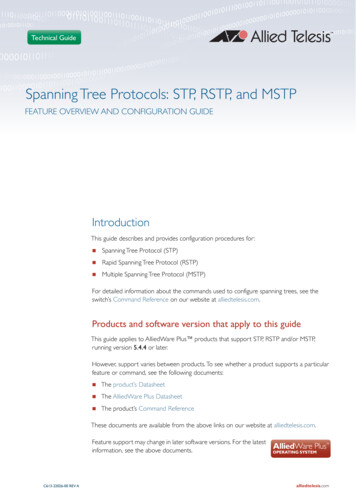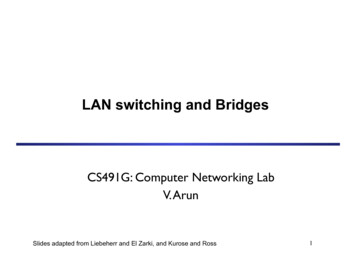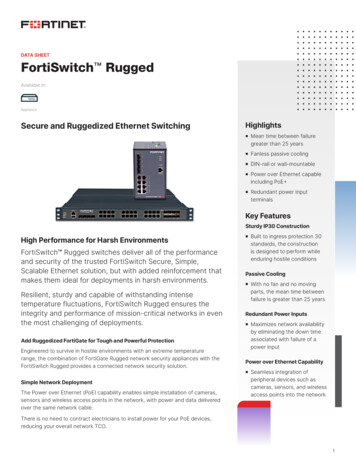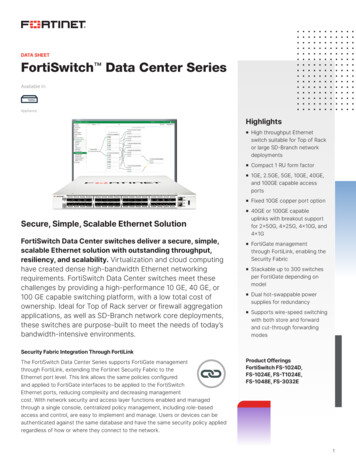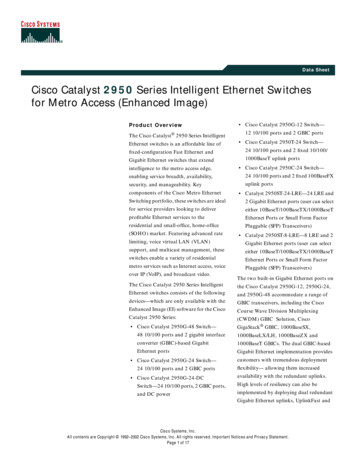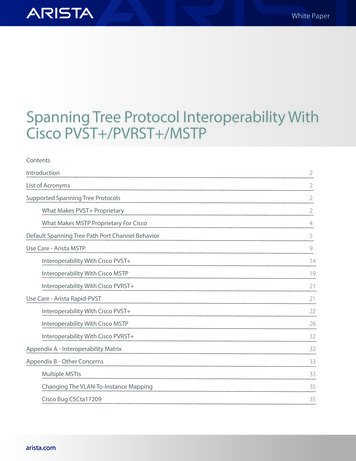
Transcription
::::::Spanning Tree Protocol/STP(to prevent switching/layer2 loops)(on bydeafult):::::::- When the redundant path exist in the layer 2 network, CAM population logicbreaks down and frames are switched out the wrong interfaces- Looping frames, expecially broadcasts, can quickly overwhelm all linkswith 100% utilization- As the network starts to grow redundandy becomes a concern (if theswitches are daisy chained and if one cable or switch goes down it shouldn'ttake down the whole network)- adding more connections between switches adds redundancy, but can causeproblems (frames that follow physical loops in the network can bring thenetwork down)- STP is desinged to fix this (allows redundant connections but preventtraffic loops)- layer3 loops are prevented using mechanisms like split horizon- STP solves the looping problem by 'blocking' redundant paths(STP tells what interfaces are actively being used to insert mac addressesin the CAM table)(blocked links cannot forward traffic or use the CAM table)(same effect as removing or shutting down the link)(can receive frames but are discarded/only STP control messages are allowedon blocked ports/no mac addresses are associated on that port and thus noforwarding on that port)- Since STP is dynamic, layer 2 network can reconverge around networkfailures- standards based per 802.1d/CST1.Switches forward broadcast packets out all ports by design2.redundant connections are necessary in business networks3.the place of spanning tree: blocks redundant links (until they are needed)4.original STP (802.1d) was created to prevent loops5.switches send "probes" into the network called bridge protocol data units(BPDUs)(a multicast packet) to discover loops6.The BPDU probes also help elect the core switch of the network, calledthe Root bridge7.The simplistic view of stp: all switches find the best way to reach theroot bridge then block all redundant links8.ARP(Address resolution protocol)- IP to MAC translation for layer 2communication can cause loops in the network9.load balancing can be done on layer 3 to send packets on more than oneredundant links but on layer 2 there is no way to do it except for seperateredundant links used for separate vlans(pvst )
(Three Port Types)(every cisco switch runs stp by default)1.Root port(Root): used to reach the root bridge (always faces upstreamtowards the root bridge)(root can never be on root bridge)2.Designated Port(Desg): forwarding port, one per link (always facesdownstream but you can send traffic out)3.Blocking/Non-Designated Port(BLK/Altn): where the link is blocked(always faces downstream you can't send traffic out)(can't associate macaddresses with this port)4.Bridge ID Priority(32768 by default/lower is better) MAC address5.All the priorities are tied by fault on all the switched so MAC addressis used to break the tie and the oldest MAC addressed switch becomes theroot brdige which could slow down the network as the oldest mac addresswill be on the oldest switch.6.all ports of the root bridge are designated ports7.there will be one (designated port) forwarding port per link8.you cannot change the mac address but can change the priority to changethe election of root bridge9.sys-id-ext is added to the priority of the switch, which is the vlan numberin which a particular stp instance is running (e.g. 32768 sys-id-ext 1 32769)(i.e. per vlan spanning-tree)10.standard stp(802.1d/not used anymore) is really slow (30 - 50 secsdowntime)(not suitable for real time application like VoIP)11.by one side blocking its port it disables the whole link (even toughthe other side keeps showing Desg/FWD)12.when all upstream root ports are elected rest of the upstream ports areblocked, where all downstream ports are designated
(How STP finds the best path?)(Root Bridge(Lowest BID)- Root Port(Lowestcost)(Lowest upstream BID)(Lowest port ID))1.Exchanges bridge and link attributes i.e. BDPU(Bridge protocol dataunits) which has bridge id(Priority MAC)(lower numerical value is highestpriority)(lowest mac address preffered)1.sent as multicast frames between adjacent bridges0180.C200.00002.(Attributes are Root ID/RootPath Cost/Bridge ID/PortID/Timers)2.elect the root bridge: (lowest BID)(lowest priority lowest mac address)3.Use lower bridge id on equal cost paths4.Use lower port to break a tie (same bridge id to we look at port IDs tobreak the tie)- Root port election per bridge: switches find lowest cost path to rootand checks the lowest bridge id and then lowest port priority10Mobps 100/100Mbps 19/1Gbps 4/10Gbps 2- (root bridge has a cost of 0 to reach itself)5.elect designated ports(How STP Loop prevention works in detail)1.All devices agree on a reference point in the network called the rootbridge (most upstream device in the topology)2.Devices directly downstream of the root bridge performs the following:1.select one upstream facing port to forward traffictowards theroot bridge called root port (based on lowestcost path and mostbandwidth)2.all other upstream facing ports are disabled called blockingports3.all downstream facing ports are called designated ports3.Next downstream device performs the same, selecting one upstream facing
root port4.repeated till loop free tree is built(Port States)1.Disabled (e.g. shutdown)2.Listening(LIS)(exchanging BPDUs with adjacent bridges)3.Learning(LRN) (Building CAM table)4.Forwarding(FWD) (Normal Loop free traffic forwarding)5.Blocking (BLK) (receiving BPDUs but not forwarding)(Progression between states)1.Disabled(e.g. shutdown or cable notconnected)- listening(15)- learning(15)- forwarding (30 seconds)2.Blocking(20)- listening(15)- learning(15)- forwarding (50 seconds)(Port Roles)1.Root(Root)2.Designsted(Desg)3.Blocked (Altn)(BPDUs/Bridge Protocol Data Units)1.sent once every 2 seconds.2.[priority mac address(i.e. switch mac address)]3.priority is some value between 0 and 61440 (default is 32768); incrementsof 4096 - lower is better4.Superioir BPDU advertisements coming in to the root(i.e best path to theroot)5.Inferior BPDU received on designated port or the blocking ports(Two Types of BPDUs)1.Configuration BPDUs2.Topolgy change notification/TCN BPDU (used when there is a state changein the network (up/down), it tells everyone to flush the CAM table and tryto recalculate where the mac address is suppose to be located)(Root Bridge election)((32768 sysID).MAC)1.lowest bridge id(BID) Lowest Priority Lowest Mac address2.BID is an 8 byte field that contains bridge priority(0-65535)(default32768) and mac address3.New standard splits bridge priority into two fields1.mac address reduction feature2.bridge priority 6 high order bits (0-61440 in increments of4096)(0 is the most prefered)3.system-id extension (12 low order bits (0-4095)/VLANs)4.Lowest BID in the network becomes everyone's Root ID (RID) in their BPDUs(Root Port election)(Lowest cost- Lowest Bridge ID- Lowest Port Priority)1.Port closest to the root bridge (root is always upstream)2.Elected based on lowest root path cost (cumulative cost of all links toget to the root/cost based on inverse bandwidth i.e. higher bandwidth, lowercost)
3.if tie in cost then chooses the lowest upstream BID- lowest upstream portID(Designated Port election)1.Ports downstream facing away from the root bridge2.Like root port, elected based on lowest root path cost- lowestBID- lowest port ID3.all other ports go into 'blocking' mode(receives BDPUs/discards all othertraffic/cannot send traffic)4.blocking ports are the key to the loop free topology(Spanning-tree transition process)(802.1d/CST(common Spanning-tree)(slowconvergence i.e. more forwarding delay (30 - 50 secs) compared toRSTP)(blocking- listening- learning- forwarding)(Problem with CST)1.Listening: 15 seconds of listening for BPDUs/switch sends and receivesBPDUs2.Learing: 15 seconds of learning MAC addresses/populate switch CAM table3.Forwarding: port is forwarding traffic4.Blocking: switch will wait up to 20 seconds (max-age) before moving ablocked port into the listening phase5.Problem with PCs: PCs can boot faster than 30 seconds- solution:S(config-if)#spanning-tree portfast6.Problems with uplink ports: 50 seconds down time causes big problems- solution: Rapid Spanning-tree7.uplink fast and backbone fast to resolve CST problem before RSTP wasreleased(STP Timers)(timers effect the transition between port states)(set onlyon the root bridge)1.Hello timer: (how often configuration BPDUs are sent/default to 2seconds)2.MaxAge timer: (how long to wait in blocking state without hearing aBPDU/default to 20 seconds)(more like dead-interval in routing protocols)3.Forward Delay: (how long to wait in each the listening and learningphases/default to 15 seconds each)4.setting the timer locally does not effect anything it must be in the rootbridge(STP Reconvergence)(20 secs MaxAge timer)1.The second BPDU type, TCN(topology change notification), is used toquickly age out the CAM table in case of a port state change (e.g.Forwarding- Down,BLocking- Designated)2.TCN is sent up to Root Bridge1.TCN sent out Root port2.Upstream switch sends TCAck in configuration BPDU back3.Upstream switch sends TCN out Root port4.Next Upstream switch sends TCAck in configuration BPDUback5.Next upstream switch sends TCN out Root port
6.Process continues until Root Bridge receives TCN3.When Root bridge receives TCN, it replies with TCN out all ports4.Result is that CAM aging time is reduced to forward dealy (deafult of5 mins reduced to 15 seconds)(PVST )(sort of manual load-balancing per vlan instance)1.Runs an instance of STP per-VLAN (sort of manual system ofloadbalancing)[priority VLAN id MAC address](e.g.32768 1 mac address)
2.allows different root bridges per vlan (one root bridge elected for eachVLAN)(separate root port and designated port elections per VLAN)(by deafultthe path selection and root bridge is the same for all vlan instances asthe priority is the same for all)(pvst instance is not created until youcreate a vlan)3.default for all cisco switches4.helps load-balance more effectively(Per-VLAN Path Selection)(layer 2 traffic engineering/path selection)1.Changing the bridge priority per-vlan basis2.Changing inididvidual port costs at the port level per-vlan basis
(Cisco's 802.1d Convergence Enhancements)(sub-second convergence)1.Portfats: (saves 30 secs)(port turns from disabled to enable stateimmidiately)(end hosts need not be subject to forwarding delay)(alsoeffects TCN generation(flushes CAM table/CAM table of the whole broadcastdomain ages-out))(if we activate portfast it will not generate TCN)(showsas p2p edge port)2.uplinkfast: (saves 30 secs)(direct root port failure should reconvergeimmidiately if alternate port avaiable)(flood the entire CAM table out toupdate the nei)(saves 30 secs i.e. LRN- LIS- FWD)3.Backbonefast: (saves 20 secs)(indirect failures should startrecalculating immidiately)(automatically expires max-age timer)(saves 20secs i.e. BLK- LRN- LIS- FWD)(if an inferior BPDU is received on the rootport that means someone upstream had a network failure and should go aroundand reconverge around it)
(Other STP Features)1.BPDU Filter:(interface level- filter BPDUs inbound/outbound i.e. do not send or receiveBPDUs in the interface by simply terminating the spanning tree domain, sortof an ACL)(global- BPDU is received revert out of portfast state/same functionalitythat rstp has with its edge ports)(so you don't have to worry aboutconfiguring portfast individually on each port)(not a security mechanism)(usually filter bpdu going to access layer)2.BPDU Guard: (If BPDU is received shut port down)(if BPDU received it putsthe port into err-disable state)3.Root Guard:(If superior BPDU is received shut port down)(e.g. in metroethernet and if you are service provider then the CE can never be the rootbridge even if their engineers make a mistake)(also used to protect fromlayer2 man-in-the-middle attack)(security mechanism)4.Loop Guard and UDLD: (unidirectional link detection)(preventunidirectional links)(usually happens if using fiber optic cable as twodifferent channels, send and receive pair, makes it full-duplex)(if onesend or receive channel goes down, then the other side could think thatthe nei is still up, but still can't send traffic etc.)(so must be sendingand receiving BPDUs)
- (root guard is activated on the downstream interfaces on distributionlayer switches and the access layer switches)- (SW3 will wait for the max-age timer to expire and will become desg portafter that which will cause loop)(its a layer 1 issue)(solution need somesort of layer 1 keep alive i.e. loop guard and UDLD)
(Rapid STP/RSTP/802.1w)(fast convergence/1-2 secs forwardingdelay)(faster convergence than cisco's 802.1d enhancements)(proactive system/redefined port roles )(remembers backup ports andconverges faster/alternate port)(simplifies port states and useshandshaking proposal/agreement process for rapid convergence)1.Root port: used to reach the root bridge2.Designated port:forwarding port, one per link3.alternate port: discarding port(blocked port), backup path to root- host ports need to be in portfast for it to be rapid(RSTP Port States)1.Discarding(LIS) (Disabled Blocking listening combined)(droppingframes)2.Learning(LRN) (dropping frames but building the CAM)3.Forwarding(FWD) (normal forwarding)(RSTP Port Roles)1.Root Port(Root)2.Designated Port(Desg)3.Alternate Port(Altn)(alternate but less desirable path to theroot)(allows the equivalent of uplinkfast)(operates in discarding state)4.Backup port (Altn) (backup designated port)(could be alternate if bothroot and designated ports go down)(operates in discarding state)5.Edge Port (Edge P2p/Desg) (e.g. IP phone, end-host etc.)(requiresportfast command)(equivalent of PVST portfast enabled ports)(immidiatelytransitions to forwarding)(maintains edge status as long as no BPDUs are
received)(if BPDU received, remove edge status and generate TCN)(Advantages of RSTP)1.it does not forget ports2.safety timers of STP are eliminated3.any changes (up/down) to the trunk ports flood through the network toother switches (TC packets)4.backward compatible with 802.1d standard- if you try to convert the uplink port to another switch into a portfastport it will not convert due to the BPDUs it detects, as it could causeloops(RSTP Link Types)(Non-edge ports fall into two types)1.Point-to-point (full-duplex ports)(only p2p designated ports sueproposal process for rapid convergence)2.Shared (half-duplex ports)(RSTP Proposal Process)1.Root bridge sends proposal out designated ports2.If downstream switch agrees that root bridge has superioir BPDU (all othernon-edge ports blocked)(agreement sent to back out port proposal receivedon)(port immidiately transitioned to root port)3.Proposal continues downstream4.Proposal and agreement process typically happens sub-second5.If no response to proposal received, revert to Listening and Learning(backward compatibility to 8021.d)(RSTP Convergence)1.In 802.1d, BPDUs are only generated by root bridge (all other bridgesforward them on)2.In RSTP, each brdige generates BPDU every hello interval (2 secs bydefault)3.If 3 hellos are missed from a nei, reconvergence begins (6 secs vs. 20secs MaxAge)(RSTP PVST )1.Same as PVST , but uses RSTP enhancements for rapid convergence2.Configured as: spanning-tree mode rapid-pvst
(Multiple Spanning-tree Protocol/MST)(802.1s)(groups vlans into singleinstance compared to cisco's versions)(automatically enables RSTP)1.IEEE (802.1s) response to PVST/PVST 2.supports multiple user-defined instances of spanning-tree (PVST usesone instance per vlan)(MST uses definable instances)3.not as resource intensive as PVST/PVST 4.Automatically runs RSTP5.highly scalable(switches with same instances, configuration revisionnumber, and anme form a 'region')(different regions see each other asvirtual bridges)6.same election process as CST/PVST ((Root Bridge(Lowest BID)- RootPort(Lowest cost)(Lowest upstream BID)(Lowest port ID)))7.VTP v3 advertises(MST with Multiple Regions/Inter-Region MTS)1.MST Region is defined by:1.VLAN to instance mappings2.Region name3.Revision number2.Inter-Region path selection uses a CST(COmmon Spanning-tree)1.Intra-region MSTIs(multiple spanning-tree instances) are collpsedinto CIST(common internal spanning-tree)- every region is considered as a cloud (as a single node for inter-regionCST/acts as one single bridge for CST) with its own intra-region rootbridge(runs MST) and the inter-region root bridge (runs CST)- so regional root bridge (is the intra-region root bridge) and root (isthe overall root bridge for inter-region)(MST Interoperability)1.MST is backwards compatible with legacy CST(802.1d) and PVST 2.Behaves like inter-region MST3.CST Root must be within MST domain
- still have the same vlan numbers overall (nothing to do with the broadcastdomain). This is to with path selection for spanning-tree(Spanning-tree nfig)#spanning-tree vlan 1,100,101 root primary (will decrease thepriority automatically)(rrot bridge macro/sets local priority based oncurrent root bridge)orS1(config)#spanning-tree vlan 1,100,101 root secondary (this is set ifyou want a switch to act as a backup for the primary root bridge)orS1(config)#spanning-tree vlan 1 priority 0-61440 (should be incrementof 4096) (to set a specific priority value/0 being the best priority)- change the mac addresses on router interfaces for the purposes of labR(config-if)#mac-address 0000.0000.0001S(config)#spa portfast default (to enable portfast on all the ports inaccess mode)S(config)#int range fa 0/2 - 24S(config-if)#spanning-tree portfast (saves 30 seconds)S1(congfig-if)#spa portfast trunk (forcing portfast even if the interfaceis in trunking mode as the other end could be a server)S1(config)#spa uplinkfast (saves 30 seconds)S1(config)#spa backbonefast (saves 20 seconds)S1(config)#int fa 0/0S1(config-if)#spa bpdufilter enable (filters out bpdu/won't send orreceive/inbound and outbound filter)S1(config)#spa portfast defaultS1(config)#spa portfast bpdufilter default (any interface where theportfast is enabled we will not be sending bpdu out)(only outboundfilter)(will not send bpdu, but will receive them)(when it receives it inthen it disabled portfast and makes it a non-edge port and starts sendingbpdu)(security concern)
S1(config)#int fa 0/0S1(config-if)#spa bpduguard enable (if receives bpdu it goes to err-disablestate)(some platforms have recovery timer on)(you can set a recovery timeron as for example if someone plug hosts on all ther access ports and sendspoofed bpdu all the ports will go into err-disable state)S1(config)#errdisable recovery interval 30S1(config)#errdisable recovery casue bpduguard (if still receiving bpduframes it will go back to shutdown)S1(config)#spa portfast defaultS1(config)#spa portfast bpduguard defaultS1(config)#int fa0/1S1(config-if)#spa guard rootS1(config)#int fa0/1S1(config-if)#spa guard loop- (UDLD definitely configured on both neighbors)S(config-if)#spa vlan 1 cost 9999 (to modify port's cost for a specificvlan number/to change the local port path cost)(Layer 2 trafficengineering/path selection)S(config-if)#bandwidth bps S(config-if)#spa vlan 1 port-priority 0-240 (modify the port id to changepath selection)(must be increments of 16)(in spa detail command it showsas designated port id 128.20, where 128 is the port priority and 20 is theport number)(so we can change the port priority)(layer 2 trafficengineering/path selection)S1(config)#service timestamps debug datetime msecS1(config)#service timestamps debug uptimeS1(config)#service timestamps log uptimeS1(config)#mac address-table aging-time 300 (i.e. 5 mins)S1(config)#spa vlan 1 hello-time 1-10 (in seconds)S1(config)#spa vlan 1 forward-time 4-30 (in seconds)S1(config)#spa vlan 1 max-age 6-40 (in seconds)(timers are set on root bridge and only then replicated to other bridges,in case of STP/PVST/PVST , whereas in case of RSTP and MST it could beanywhere)(fastest you can converge with normal stp is hello 1 sec,foward-delay 4sec and max-age 6sec, but we need sub-second convergence)R1(config)#brdige 1 protocol ieee (to turn stp,vtp,cdp etc. on the router)R1(config)#bridge 1 priority 65535 (highest priority least likely to bethe root bridge)(if you set priority 0 it will try to become root bridgedepending on if the root guard featue it set)R1(config)#int fa0/0R1(config-if)#bridge-group
::::::Verification/Show commands::::::sh spa(Root ID/Bridge IDsh spa vlan 1- priority/address/cost/port/hello timer)(to see spa of specific vlan instance/shows timers)sh spa detail- (shows BID/sys-is/mac/cost/port(root/desg(FWD)/Blk) for both currentbridge and root)- (designated path cost remote neighbors cost to reach the root advertisedto us/0 means it directly connects to the root)(path cost of root bridgesend to the neighbor is always 0)- (port path cost/root path cost cost to reach the nei who is advertisingdesignated path cost)- to check if sending and receiving BPDUssh spa vlan 1 detail (separate topology databases per vlan)sh spa root (shows the cumulative path from end to end/instead of lookingat sh spa detail we can see the path cost from here)sh spa int fa0/13 detailsh spa int fa0/13 detail in bpdu (shows if send/receiving BPDUs)sh spa int fa0/1 portfast (shows if portfast enabled for all the instances)sh interface statussh run int fa0/16sh cdp neish mac address-table dynamic vlan 1 (blocking port won't show up as trafficis being forwarded the other ports)sh arparp -a (PC command)sh processes cpu (cpu utilization)sh processes cpu history(shows graph of cpu history over time)ping 192.168.1.1 repeat 10000sh int trunksh run in spanningsh int fa0/1 switchportsh errdisable recoveryclear arp (clearing arp cache)sh mac address-table aging-timeclear spa counterdebug spadebug spa events(clears the bpdu counters in sh detail command)(shows progression to different phases)
debug spa uplinkfast (shows if receives inferior bpdu)debug spa backbonefast(Rapid Spanning-tree Protocol/RSTP-PVST)(smilar commands as fig)#spanning-tree mode rapid-pvst- no need to configure uplinkfast or backbonefast but you can configureportfast for fast convergence.- rest of the mechanisms like path selection and root election are the sameas CST except for the fast convergence::::::Verification/Show commands::::::sh spa- (every end host port must be edge port for rapid convergence and can bedone by portfast ----------------------
- in case of etherchannel/port-channel cumulative bandwidth of memberinterface/individual ports is considered for stp path cost- blocked links are only used for ------------------(Multiple Spanning-tree 1(config)#spanning-tree mst configurationS1(config-mst)#name MST REGION1S1(config-mst)#revision 1S1(config-mst)#instance 1 vlan 10, 20, 30S1(config-mst)#instance 2 vlan 40, 50, 60S1(config)#spanning-tree mode mst (it will come up with a message if theother nei switches are still on stp/rstp and blocks the links/so need prettybig maintenance windows if done in the production network)- (vlans not assigned to any instances will fall back to deafault instance0)S1(config)#spa mst 1 root primary (1 is an instance)S1(config)#spa mst 1 root secondary (1 is an instance)S1(config)#spanning-tree mst 1 priority 4096 (1 is the instance)S1(config)#int fa0/13S1(config-f)#spanning-tree mst 1 cost 50000 (path selection/layer2 trafficengineering)
S1(config-if)#spa link-type point-to-pointS1(config-if)#spa link-type sharedS1(config)#service timestamps debug datetime msec::::::Verification/Show commands::::::sh spa mstsh spash spa mst 1 (cost values in mst are larger)(1 is the instance)sh spa mst 1sh spa mst config (shows vlans corresponding to instances)sh run inc spash spa root (if the root port shows is empty for an MST instance that meansthe current bridge is the root for that particular instance)sh vlan bri (does not match with sh spa mst config)(vlans that we createare advertised by vtp)(so vtp will work for vlans showing here)debug spa mst statesdebug spa mst proposalsdebug spa mst roles(MST with Multiple Regions):::::::::Commands/Config::::::::::::
#spa mst 0 cost 200000000 (for path selection between regions)S(config)#spa mode pvst (using pvst in one of the regions)::::::Verification/Show commands::::::sh spa mst (bridge info/root bridge/regional root bridge info)(showsboundry links to other RSTP domains i.e. p2p bound(RSTP) or p2pbound(PVST))(shows what sort of interoperability are you running)shshshshshshshspaspamacsparunintintmst detailrootaddress-table dynamic vlan 10 in spafa0/1trunk
- region 3 is still the root for the regions- CST Root must be within MST domain(Flex Links)(used as opposed to STP)- allows link redundancy without STP (primary link forwards while backuplink blocks)- MAC-Address Move Update allows for faster convergence of CAMSW2(config)#int fa0/17SW2(config-if)#switchport backup int fa0/13 mmu primary vlan 1SW2(config-if)#mac address-table move update transmitSW1(config-if)#mac address-table move update receiveSW2(config)#int fa0/17SW2(config-if)#switchport backup int fa0/13 preemption mode forcedSW2(config-if)#switchport backup int fa0/13 preemption delay 5- preemption value can be set once the primary is back up againS(config-if)#switchport backup interface fa0/13 prefer vlan 1-10(for
load-balancing specific vlans per port/its not per packet or per frameload-balancing rather vlan specific load-balancing)sh mac address-table move updatesh interface fa0/17 switchport backup (shows the active and backup portsstatus)sh mac address-table dynamic vlan 1sh int switchport backup -------------------- All the priorities are tied by fault on all the switched so MAC addressis used to break the tie and the oldest MAC addressed switch becomes theroot brdige which could slow down the network as the oldest mac addresswill be on the oldest switch.(e.g. access layer switch end up becoming aroot bridge, which slows down the network completely)- STP root should be in the core of the network and if you are using threetierd desgin the STP root should be in the distribution layer
-------------Topology e-volume-1-lab-diagrams/
4.original STP (802.1d) was created to prevent loops 5.switches send "probes" into the network called bridge protocol data units (BPDUs)(a multicast packet) to discover loops 6.The BPDU probes also help ele

